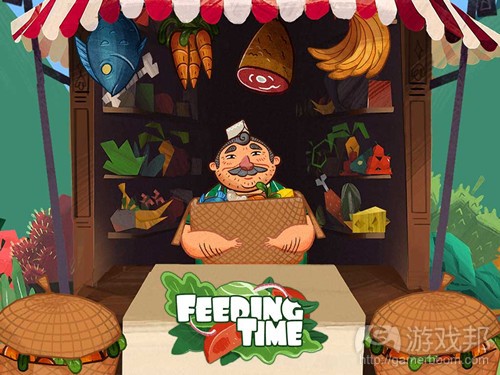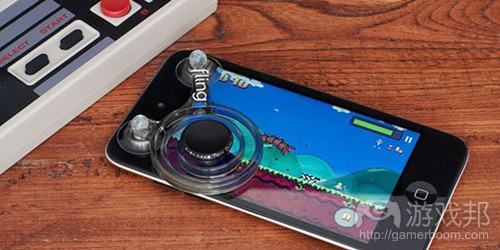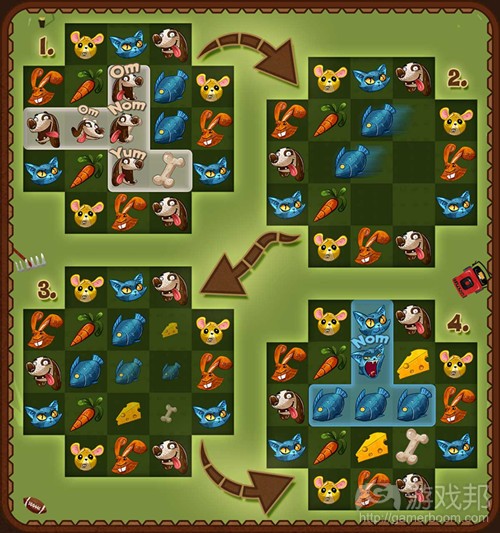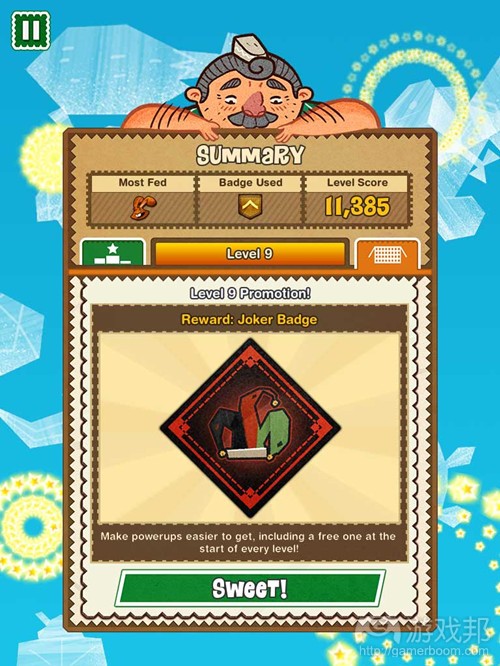手机游戏《Feeding Time》的设计要素
作者:Radek Koncewicz
《Feeding Time》是我们的工作室(Incubator Games)即将发行的一款iOS益智游戏,需要玩家使用动物最喜欢的食物与之相匹配。游戏是针对触屏设备并充满许多魅力与奇思妙想。我们希望在此分享一些开发过程中所吸取的设计教训。
原型创建
一开始,《Feeding Time》是作为一个致力于探索手机市场的小型项目而开始。我们知道可以使用虚拟棒去避免平台游戏或射击游戏的固定套路,但我们的早期原型(使用了各种角色)的表现却不怎么样。当然了,存在一些简单的方法能够让我们在触屏上有效地控制玩家角色(游戏邦注:例如《愤怒的小鸟》中拉回弹弓的机制),但是这些方法却不适用于实时游戏中。玩家的手总是会变成阻碍,最好的情况便是造成不便,而最糟糕的情况则会让玩家大大受挫。
我们决定重新开始,即打算尝试一种完全不同的方法。使用触屏的一个优势便是我们可以在任何时候敲击它的任何领域。这能够有效推动玩家与游戏间的互动,所以我们选择创建一款基于刷任务的简单益智游戏原型。匹配动物与它们常吃的食物似乎是一个不错的起点,遵循着这一主题我们尝试了一些机制,且并未将其变成简单的三消游戏。
最后我们选择在面板边缘让动物包围着食物。这解决了玩家的手会妨碍游戏的问题,同时提供了一种特别的挑战:基于这种方式操控面板将把食物朝着动物的方向聚集。
1.面板左边的狗将与骨头相匹配。
2.当骨头都消失时,剩下的食物将滑下左边。
3.面板上空出的位置将填满新的食物。
4.猫将开始与鱼相匹配—-当匹配完成后,下方的食物也会上滑。
我们最终将面板的规格设定为10×10网格大小。这让我们能够创造最小的32×32像素的食物和动物,当面向不同屏幕规格时,这也非常符合2的乘方规则。
最终,我们添加了一些能量作为玩家创造更大匹配的奖励。这不仅向游戏玩法中引入了全新的动态元素,让玩家能够在适当的时间节省食物变化的能量,同时也能够解决随着时间的发展游戏面板变得更加杂乱的问题。
手机惯例
尽管我们拥有一个有趣的原型,但它却还不具有典型的便携式体验。我们决定处理的第一个问题便是游戏长度。尽管提升了每一回合的时间长度,但是平均的游戏持续时间仍然很低。作为“闪电战”这类型游戏模式(就像《宝石迷阵闪电战》每个阶段的时限是60秒)的粉丝,我们添加了时限和分数排行榜到《Feeding Time》中。后者同样也非常适合游戏的竞争性/社交元素。
这次的试验非常成功,但仍然引出了一个问题:较大的匹配需要花费更长时间。
因为较大的匹配是游戏玩法的主要目标,它们的长期执行将与关卡计时器形成矛盾。然而,因为不想放弃“闪电战”的理念,我们调整了动物的速度,计时器的持续时间以及食物四处滑动的速度等等。尽管这些调整带来了一定的帮助,但是却未能解决在时间快到之际被动等待匹配的完成这一根本问题。
当我们决定让游戏面板实时回应事件的发展而不受刻板模式束缚时,我们终于创造了突破性的的进展。通过让玩家开始新的匹配同时仍执行着早前的匹配,我们有效地避免了游戏玩法中的停机时间。我们创造了一个可以巧妙执行的“活跃”面板,并且需要处理它所带来的各种困难的漏洞,但即使这样,最终的结果仍然是有趣且充满活力的体验。
像《Jetpack Joyride》等手机游戏所兴起的另一个元素便是迷你目标理念。即为玩家提供一列特殊成就目标(让他们完成),从而添加了游戏玩法多样性并提供了成就的二次来源,你并不需要在最后关卡获得高分,但你最终可以不受打击地完成它。
我们并未猜到的便是,这些目标竟然能够作为游戏教程!在测试过程中我们发现让玩家记住技能和信息比迫使他们玩游戏教程更有效。
最后,我们希望《Feeding Time》拥有一个切实的进程感。为了做到这一点,我们添加了关卡系统这样的RPG元素,同时还伴随着轻微的调整:玩家的实际分数,目标奖励等等将作为体验点数。这意味着带有技能的玩家能够更快速地前进,但经过证明这一方法的影响并不大。相反地,我们获得一系列中间目标能够创造出全新动物,位置,能量等等内容即将出现的感觉。
我们还考虑到了其它业务,市场营销和游戏玩法惯例等等,但所有的这些内容似乎侵犯了游戏的核心机制,所以它们并未真正发挥作用。
结论
面对着大致完成的基础游戏,我们的团队决定添加各种功能:在完成三个目标后的特殊迷你游戏,每个区域设定独特的能量,提供各种游戏玩法变更的标志,以及外观装饰。
我们清楚所有的这些努力都将有力地推动这一项目的发展,并最终创造出更加完善的体验。许多手机游戏总是会让人觉得太过粗糙,像是匆忙赶制的结果,这也是我们在最初的IP发行时想要避免的情况。希望你们在看到《Feeding Time》时会觉得这是一款有价值的游戏。
原文发表于2013年11月25日,所涉事件和数据均以当时为准。
(本文为游戏邦/gamerboom.com编译,拒绝任何不保留版权的转功,如需转载请联系:游戏邦)
Mobile Design Considerations in Feeding Time
by Radek Koncewicz
Feeding Time is our studio’s (Incubator Games) upcoming iOS puzzle game that tasks the player with matching adorable animals with their favourite types of food. The game is aimed specifically at touch-screen devices and filled with as much charm and whimsy as we could stuff into it. It’s also slated for an early 2014 release, and we’d like to share some of the design lessons learned during its development.
Prototyping
Feeding Time started off as a small project geared toward exploring the mobile market. We knew enough to avoid shoehorning in a platformer or shooter with virtual sticks, but our early prototypes that used any sort of avatar didn’t fare well either. Sure, there were some neat ways of controlling a player character on a touch screen (e.g., the mechanic of pulling back the slingshot in Angry Birds), but none of them felt particularly satisfying in a real-time game. The player’s hand would always get in the way, and that led to inconveniences at best and frustration at worst.
Going back to the drawing board, we decided to try a different approach. One of the advantages of dealing with a touch screen is that various areas of it can be tapped at any time. This makes it perfect for interacting with a game-board, so we chose to prototype a simple grid-based puzzle game. The idea of matching animals with their commonly associated snacks seemed like a good starting point, and we experimented with a few mechanics that followed this motif without deteriorating into a simple match-3 game.
In the end we chose to have the animals surround the foods on the edges of the board. This limited the issue of the player’s hands getting in the way while providing a unique challenge: maneuvering the board in such a way that the foods clustered next to their corresponding animal.
1.Dogs on the left side of the board are matched with a series of bones.
2.When the bones are all gone, the remaining foods slide left to take their place.
3.Empty spots on the board are then filled with new foods.
4.Cats begins munching on some fish — when they’re done, the foods at the bottom will slide up.
We played around with the size of the board as well, but eventually settled on a 10×10 grid. This allowed us to make the smallest foods and animals 32×32 pixels, which nicely accommodated the power-of-two rule when scaling to different screen sizes.
Finally, we added some tap-to-activate powerups as a reward for making large matches. These not only introduced new dynamics to the gameplay, e.g., letting player save a food-mutating powerup for just the right time, but also alleviated the problem of the game board getting too scrambled over time.
Mobile Conventions
While we had a fun prototype, it wasn’t quite crafted for a typical hand-held experience. The first aspect we decided to address was the game length. While session times have been on the rise, the average duration of play for a mobile game is still fairly low. Being fans of the “Blitz” model — 60 second time limit per stage popularized by Bejeweled Blitz — we added a time-limit and score leaderboards to Feeding Time. The latter also nicely fit into the competitive/social aspect of the game.
The experiment worked out quite well except for one glaring issue: large matches took a long time to play out.
Since large matches were the main goal of the gameplay, their prolonged execution clashed with the level timer. However, not wanting to give up on the blitz concept we messed around with the speeds of the animals, the duration of the timer, the pace at which the foods slid around, etc. While these tweaks helped, they didn’t solve the fundamental problem of passively waiting for a match to finish while the timer ticked down.
Our breakthrough finally came when we decided to make the game board respond to events in real-time instead of a lock-step fashion. By allowing the player to start new matches while old ones were still executing, we largely removed downtime in the gameplay. Granted a “live” board can be quite tricky to implement, and we had to deal with a variety of difficult bugs it introduced, but the end result was a much more fun and dynamic experience.
Another element popularized by mobile games such as Jetpack Joyride is the idea of mini-goals. These provide a list of specific achievements for the player to complete that add gameplay variety and providing a secondary source of accomplishment, e.g., you didn’t get the high score on the last level, but you finally got through it without getting hit.
What we didn’t expect is how suitable these goals would be to serving as the game’s tutorials! Instead of implementing a plethora of gated, hand-hold-y segments every time a new powerup or gameplay element was introduced, we simply made it into a goal. During playtesting this proved to work much better at getting players to retain skills and knowledge than simply forcing them to play a tutorial.
Finally — and despite the short sessions times — we wanted Feeding Time to have a tangible sense of progression. To achieve this, we added an RPG like leveling system with a slight twist: the player’s actual score, goal bonuses, etc., would serve as the experience points. This meant that skilled players would potentially advance a little bit faster, but this proved to have a minimal impact. Instead, we got a series of meta-goals that helped to create a feeling that new animals, locations, powerups, etc., were just around the corner.
There were other business, marketing, and gameplay conventions we considered as well, but all of them felt like they encroached on the game’s core mechanics so they never quite left the drawing board.
Final Touches
With the base game more or less complete, our team decided to add a variety of features: special minigames played after completing three goals, unique powerups for each area, equipable badges that provide various gameplay modifications, and countless aesthetic flourishes.
Predictably all these efforts added a significant amount of work to the project, but they made for a much more refined experience. Many mobile games feel rushed and rough around the edges, and that’s something we wanted to avoid with our first original IP release. Hopefully you guys will agree it was worth when Feeding Time is released early next year!(source:gamasutra)











































 闽公网安备35020302001549号
闽公网安备35020302001549号